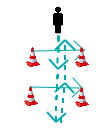Basketball drills
- Players stand ready at the halfway line. The first one has a ball (then 2 without the ball).
- X1 makes lay-up
- X2 takes rebound and passes in (after scoring!)
- X3 runs around the pot and starts defending
- X1 and X2 attack to the other ring
- variation: with 5
- X1 makes lay-up
- X2 takes rebound and gives in (after score!) to X3
- X3 dribbles over, X1 and X2 fill in the outer lines.
- X4 walks around the basket near the baseline and defends.
- X4 runs around the ball at the halfway line (other side) and defends.
This drill can serve well as a warming up drill (passing / finishing) but is also a good breakdown for a "scissor" play, or "split the post". You can expand the drill to include other options that may or may not be used in your set play. You start off basic, simple, and as your team is ready, you expand the exercise further and further.
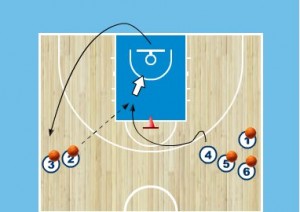
- The exercise starts with two rows on two spots (e.g. 2 guard spots).
- If you have a larger team, you work on 2 baskets. Again, we would like to see everyone finish as many balls as possible.
- So make the groups as small as possible, but at least 4-6 players per basket.
- #1 starts the exercise by making a preliminary move ("setting up" the defender) and cutting tightly over the pawn (or chair).
- As a trainer you can also stand here for a while as a high-post so that it becomes recognizable for the players.
- #4 passes the ball to the cutting in #1 and after his pass he immediately makes another pre-move and cuts across the pawn in the same way, then gets the ball from #2.
- Rotation: Each player catches his own ball, and joins the line from which he received the ball. The exercise continues in this manner continuously.
Variations:
- Vary speed. The players must first master the technique of cutting in. Set up a man, push off and accelerate, etc. (see teaching points). Then increase the pace.
- Receive and shoot the ball;
- Make a pop-out (when a defender passes underneath) and shoot;
- Train aggression with pad, unbalance players when cutting in;
- After cutting in, offer the ball at the low post and finish with a post move (also think of countermoves), use pads here too;
- Work with a high-post player (trainer or one of the players): Pass the ball to the high-post first and then: hand-off / hi-lo, etc (depending on your own options);
- Eventually work with defenders involved as well;
Teaching Points:
- Set up defenders;
- Push off on the outer foot and accelerate (change of direction = change of speed)
Aggressive cutting in!
- Cut straight over the pawn, do not make wide turns ("shoulder to shoulder");
- Communication in the passing game, seeking eye contact, clearly asking for the ball with the front hand, asking in front of the man and running into the ball;
- Finish from the left side with the left hand, and the same applies for the right side;
- three groups of two per basket
- try to make qualitatively equal pairs
- How?
- 1 pair in front, 2 in forward positions
- take turns making a drive, alternating attack/defence
- First of the pair to have 5 points, wins.
Requirements:
players must be able to run a lay up from a bounce pass
Goal: learn
how to punish the overplaying of the forward by an aggressive defense
Organization:
- guard dribbles up from behind the centre circle
- at the same moment the centre 4 comes to the elbow
- and player 3 sprints to the pawn
- 1 passes to 4 with a bounce pass
- 3 sprints to the basket with a sharp change of direction and speed
- and receives the bounce pass from 4
Rotation:
- 4 grabs the rebound
- and takes the ball on the back line
- 3 goes to defend the inbound pass
- when 9 receives the ball, 7 takes position at the sideline for the next inbound pass
- 4 and 5 do not rotate but take turns.
- 1 joins the line behind the pawn
- 9 passes the ball to 8 and joins the row behind it
Variation:
- 1 pretends he is going to put a screen away on the weak side, but cuts to 4 for a hand off
- takes the shot
- OR plays pick and roll with 4
Teaching Points:
- Sprint to the pawn: when passing, you as the attacker must take the defender well outside the three-point line to make enough space for the backdoor.
- 1 has to feint immediately after the pass to be in time for the hand off.
Line up at the free throw line and try to out-maneuver each other
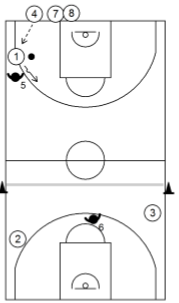
Prerequisites:
players on the dribble can defend Â- and can make a pass the length of the field
Objective:
to practice defending the backfield in the arrowpress Â- to anticipate the pass and always make sure you are in a position to intercept it
Organisation:
- 4 takes the ball and then does not take part in the game anymore, but counts down the seconds
- defender 5 applies maximum pressure on the dribbler
- the defenders can defend all over the field
- attacker 1 may only act on the defensive half Â- attackers 2 and 3 only on the offensive half
- after a stop or score, defender 5 takes the ball back for the next round
- if the attackers score within 10 seconds they have a point Â- if not, it is a point for the defenders Â- the attacker calls if there is a foul on him. Point for the attack.
- play 5 times in a row with the same defenders
- 3 new attackers each time.
- If the defenders make less than 2 stops, they must run.
- when there are 2 or more stops, all attackers must run.
Teaching points:
defend the dribbler on your feet - he may not pass you under any circumstances Â- arms wide to make a pass difficult Â- defender 6 must anticipate the long pass to intercept it Â- must position himself so that he can see the ball AND both other attackers as much as possible (split vision) Â- always adjust his position on the field to intercept the most likely pass Â- if he has not been able to intercept the long pass, Â- He must NOT allow a lay up Â- Defender 5 must then sprint full speed towards the free attacker on the weak side.
Variations:
In the beginning, you may have to limit the space for attackers 2 and 3. Use existing lines on the floor, or place pawns on the sidelines on the attacking half.
- The player gets the ball thrown to you
- Do a crossover and shoot the ball at the first position
- Do the same at the second position
- And so on
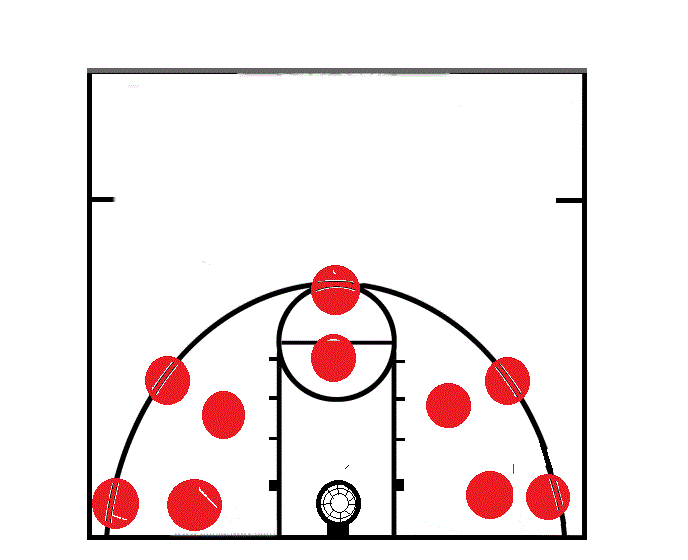
Players gather on the right or left side of the center line.
The first two have a ball.
There are two catchers under the basket.
From the center line you dribble to the basket and make a lay-up.
The catcher catches the ball and passes it to the next player in line.
You do this until you have scored 15 times and then you change sides.
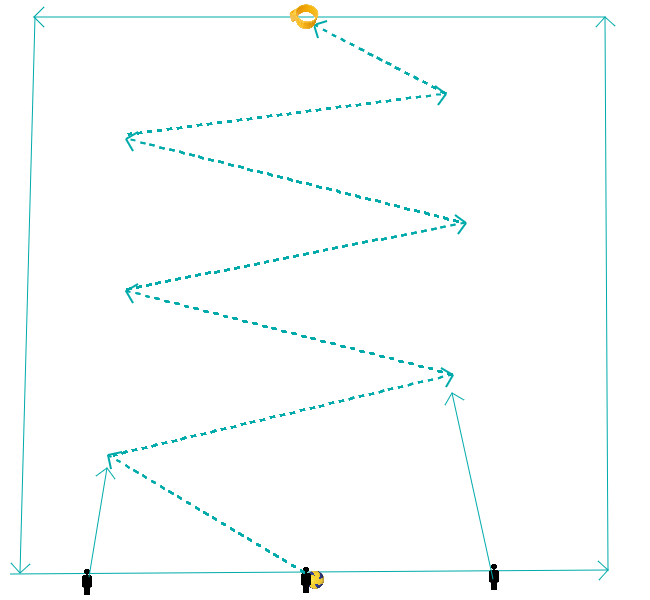
With 3 men on the back line and the middle one has the ball- The middle passes to a man and runs after the ball
- The man in the middle passes to the man on the other side, who also runs after the ball.
- They do this while running to the basket on the other side.
- When someone is close enough to the basket, the man runs a lay-up.
- He becomes the defender and the other two attackers must try to reach each other with a long ball.
- The goal of the defender is to prevent the attackers from scoring.
- If the attackers do not manage to score, they must do 5 push-ups.
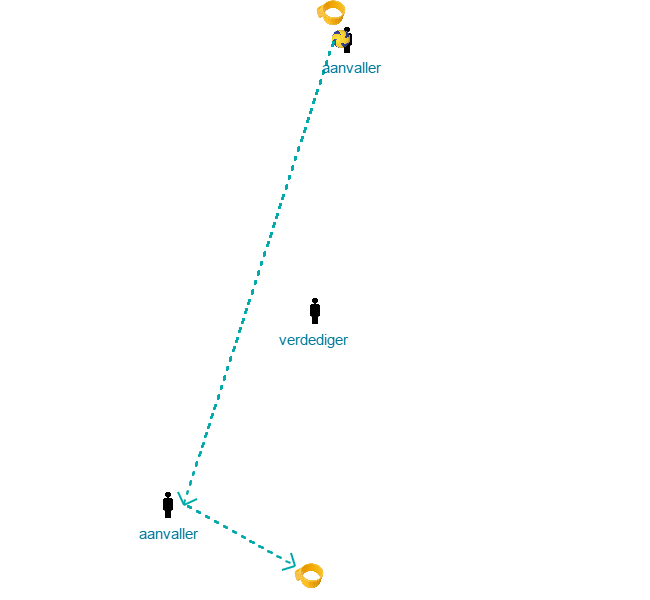
- One person shoots free throws.
- Two other players stand behind the one who shoots the free throws. (According to the rules of the game)
- Once the ball is gone, the three players go for the rebound.
- If the person who threw the free throw has the ball, he can take another free throw.
- If he does not have the rebound, the three players are replaced by the next three.
3 attackers have a ball + 1 defender lined up as in the picture on the right.
The defender starts tipping in the middle of the bucket.
The coach calls out the name of one of the attackers (or a number).
When the name is called, the defender sprints to the right attacker and follows one of three commands:
X1 dribbles via the baseline 2 to 3 dribbles. The defender takes a charge here.
X2 makes a shot fake, the defender makes a close out. Later expand to fake + dribble.
X3 dribbles from the baseline to the basket. The defender has to close out the baseline here.

- 4 pawns with ribbons (positioned low to the ground)
- 1 basketball per person
1. The player jumps over the ribbon with 2 feet at the same time, while holding the basketball in front of him at chest height.
2. The player jumps backwards back to the middle.
3. In the middle, the player makes a jump bringing the basketball up (arms extended) and the player makes a 180 C turn.
4. The exercise repeats facing the other side.
